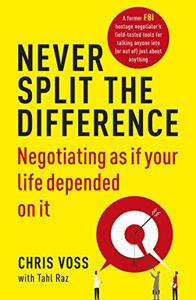
Want to learn the ideas in Never Split the Difference better than ever? Read the world’s #1 book summary of Never Split the Difference by Chris Voss, Tahl Raz here.
Read a brief 1-Page Summary or watch video summaries curated by our expert team. Note: this book guide is not affiliated with or endorsed by the publisher or author, and we always encourage you to purchase and read the full book.
Video Summaries of Never Split the Difference
We’ve scoured the Internet for the very best videos on Never Split the Difference, from high-quality videos summaries to interviews or commentary by Chris Voss, Tahl Raz.
1-Page Summary of Never Split the Difference
Getting Past “Getting to Yes”
Negotiation theory was developed in 1979 by the Harvard Negotiation Project. The project focused on using negotiation techniques to solve problems in business, hostage situations and more. One of their books, Getting to Yes, argues that you can overcome irrational emotional responses with thoughtful reasoning during a negotiation session.
The FBI, NYPD and other agencies praised the book as a negotiation bible. It has been used to train police officers in crisis intervention skills. The original theories proposed by the authors did not hold up when they were tried out in real life situations like Ruby Ridge and Waco so CIRG was formed to develop tactics that would work better for these situations. CIRG focused on crisis intervention and trained negotiators how to handle fluid situations with hostage takers by creating a calm atmosphere, establishing connection, gaining trust, demonstrating empathy and eliciting cooperation from them.
Two economists and psychologists, Amos Tversky and Daniel Kahneman, have found that people are not entirely rational. Instead of being completely selfish or logical, they operate on two systems: the emotional System 1 and the logical System 2. Negotiators must influence their counterparts’ feelings if they want to get what they want in negotiations.
“Mirrors Work Magic”
In 1993, a bank robbery took place in Brooklyn, New York. Law enforcement was called in to negotiate with the robbers and ensure their safety as well as that of the hostages. The leader of the group was afraid and didn’t have full control over his accomplices. He referred to “we” when he actually meant himself alone. Therefore, law enforcement had to start by observing him before they could extract information from him about what he needed or wanted. In addition, they had to get him talking and feel safe around them so that he would willingly divulge more information about himself and his gang members (who were really just one other person). They also had to keep themselves calm at all times so that they wouldn’t agitate the situation even further. Finally, time is always on a negotiator’s side because it allows for more opportunities for resolution without having any negative impact on either party involved in negotiations.
The concept of “mirroring” is a way that humans subconsciously imitate each other. It’s something people do when they’re attempting to build rapport and establish commonalities. FBI negotiators employ this strategy by repeating the last few words in a person’s sentence back at them, which helps them better understand the other party’s feelings and intentions. This technique helped them talk down potential criminals who had taken hostages, as it allowed both parties to learn from each other throughout negotiations.
“Tactical Empathy”
If you know your emotions and your counterpart’s, then you can communicate with each other better. In one case, the FBI negotiator talked to a couple of fugitives who had hidden in an apartment for six hours. The negotiator used tactical empathy to understand how they felt about getting caught or being shot by police. He didn’t agree with their point of view but he showed that he understood it by repeating what they said and showing his understanding of their feelings as well.
To use this tactic, don’t feel their pain. Acknowledge it instead and label it. When you do that, you validate the other person’s emotions and make him or her feel understood. Labeling someone’s feelings is a great way to empathize with them and understand what they’re going through. It also diffuses the power of those feelings by acknowledging them up front so they won’t be as threatening later on in the negotiation process.





